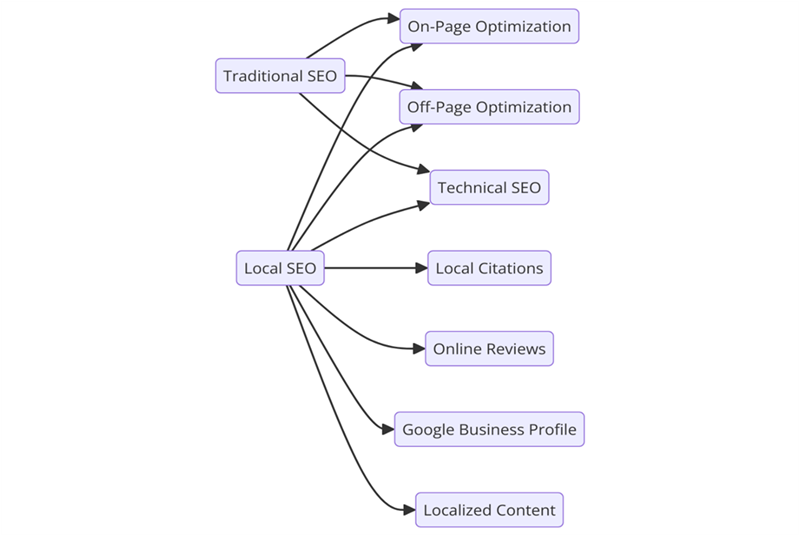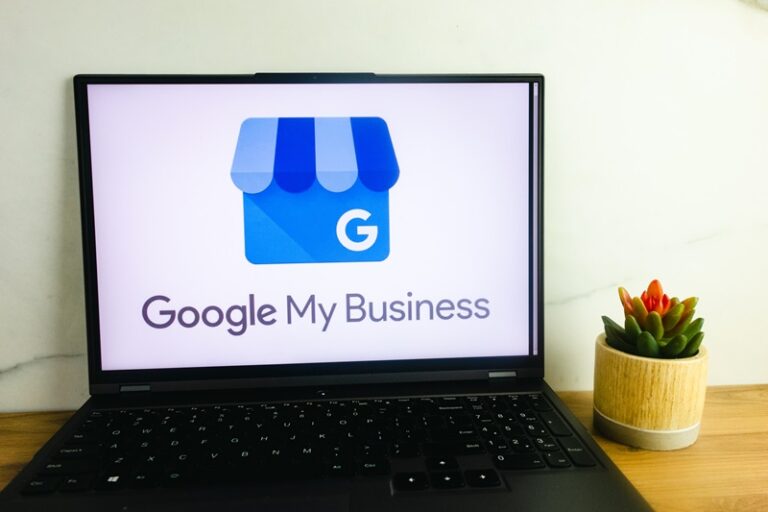Understanding the differences between classic SEO and local SEO is crucial for organizations seeking to improve their online presence. There are notable distinctions in the approaches and target audiences of both tactics, despite their shared objective of improving search engine rankings. This article explores the differences in detail and provides practical tips for enhancing a company’s online presence.
What is Traditional SEO?
SEO typically aims to enhance a website’s visibility on a broader scale, either nationally or globally. Website optimization is all about improving different elements to boost search engine rankings. The main objective of conventional SEO is to broaden the audience reach by enhancing the website’s accessibility and relevance to search engines such as Google, Bing, and Yahoo.
Key Strategies of Traditional SEO
1. Keyword Research
Identifying and Targeting Broad, High-Volume Keywords
Researching keywords is crucial for effective SEO strategies. Identify and target popular keywords that potential customers use when searching for information related to your business. Discovering keywords is made easier with tools like Google Keyword Planner, SEMrush, and Ahrefs. Our goal is to choose keywords that are widely searched for but don’t face too much competition. This will help us achieve a higher ranking in search results.
2. Content Creation
Creating top-notch, pertinent content is essential for captivating and involving a broad audience. I specialize in crafting concise and informative blog posts, articles, and web pages that cater to your target audience’s needs and inquiries. Ensure that the content is informative, thoroughly researched, and tailored to the selected keywords. Keeping the website up-to-date with new content is essential for boosting rankings and keeping the audience interested.
3. Link Building
Obtaining Backlinks from Trustworthy Websites: Link building is a strategy that focuses on acquiring backlinks from reputable websites in order to enhance domain authority. Search engines view backlinks as a sign of trust and value in your content. Obtaining backlinks can be done through various techniques. One way is through guest blogging, where you contribute articles to other websites. Another method is creating shareable infographics, which can attract attention and links. Additionally, reaching out to industry influencers and bloggers can help in building backlinks. These strategies can be effective in increasing the number of links to your website. Having a solid backlink profile can greatly improve a website’s search engine rankings.
4. On-Page Optimization
Enhancing Website Elements: On-page optimization focuses on refining different aspects of a website to enhance its search engine compatibility. We ensure that meta tags (title tags, meta descriptions), headers (H1, H2, H3 tags), and images (alt text, file names) are all optimized. Optimizing your website’s content is crucial for search engines to comprehend and index it effectively, ultimately boosting its visibility in search results.
5. Page Speed
Improving Site Speed: The speed of your website pages is crucial for a positive user experience and higher search engine rankings. Optimizing load times can result in decreased bounce rates and increased user engagement. There are several techniques you can use to enhance your page speed. These include optimizing your images, leveraging browser caching, minifying CSS and JavaScript files, and utilizing Content Delivery Networks (CDNs). Page speed is crucial for SEO performance because search engines like Google take it into account when ranking websites.

What is Local SEO?
Local SEO focuses on enhancing a company’s presence in local search results. Businesses that cater to specific geographic areas, like restaurants, hotels, law firms, medical practices, and local service providers, must prioritize this. Our main aim is to reach out to nearby customers and make sure that when people search for our services or products, we show up prominently in local search results.
Key Strategies of Local SEO
1. Google My Business
Claim and optimize. Manage your online presence across Google with Google My Business (GMB). This free tool helps businesses easily handle their listings on Search and Maps. Optimizing a GMB listing is a highly effective strategy for boosting local SEO. It is important for businesses to have a complete and accurate profile. This includes providing information such as the business name, address, phone number, business hours, and categories. Including top-notch images, promptly addressing customer reviews, and consistently sharing updates can also boost the effectiveness of the listing.

2. Local Keywords
Focusing on Location-Specific Keywords: Local SEO places a strong emphasis on targeting keywords that are specific to a particular location. Using the business’s location and services or products, you can create effective keywords. One way a dentist in Boston can optimize their online presence is by focusing on specific search terms such as “Boston dentist” or “dental services in Boston.” In order to optimize the website for local searches, it’s important to include these keywords in the content, meta tags, and URLs. This will help search engines recognize the business’s relevance.
3. Review Management
Online reviews are crucial for building local credibility and improving local SEO. Good reviews can enhance a company’s image and boost its presence in local search rankings. It is advisable for businesses to prompt content customers to share their feedback on platforms such as Google, Yelp, and industry-specific review sites. Responding to reviews, whether positive or negative, is crucial to demonstrate the business’s dedication to customer feedback and commitment to exceptional service.
4. NAP Consistency
Consistency is key when it comes to your business’s online presence. Make sure that your business name, address, and phone number are the same across all platforms. This will help maintain a professional image and make it easier for customers to find and contact you. Keep it simple and straightforward, using short sentences to convey your message effectively. NAP is an acronym that represents Name, Address, and Phone number. It is important to maintain consistent NAP information across all online platforms, such as the business’s website, social media profiles, and local directories, in order to optimize local SEO. Having inconsistent NAP information can cause confusion for search engines and potential customers, resulting in lower search rankings and diminished trust. Having accurate and consistent NAP details is crucial for search engines to confirm the legitimacy and relevance of a business in local searches.
5. Local Citations
Adding the Business to Local Directories and Citation Sites: Local citations refer to online mentions of the business’s NAP information. Adding the business to well-known local directories and citation sites, such as Yelp, Yellow Pages, and industry-specific directories, can enhance local search visibility. These citations contribute to the business’s online presence and credibility, simplifying the process for search engines to verify the business’s location and relevance. It is crucial to maintain accurate and up-to-date listings for a strong local SEO strategy.
Key Differences Between Local SEO and Traditional SEO

Target Audience
- Traditional SEO: Appealing to a wide range of readers, whether they are from different regions, countries, or even continents. SEO is typically aimed at reaching a broad audience, both nationally and internationally. Our strategies focus on enhancing website visibility and reaching a wide range of potential customers. This method works well for businesses that provide products or services that can be accessed from anywhere and cater to customers in different areas.
- Local SEO: Targeting customers in a specific local area. Local SEO focuses on reaching customers in a specific geographic area. Our main goal is to attract nearby customers to our physical location. This approach is especially advantageous for businesses such as restaurants, retail stores, and local service providers. It helps them improve their local search rankings and attract more customers from the area.
Keyword Strategies
- Traditional SEO: Emphasizes commonly used keywords that are frequently searched for. Conventional SEO places importance on popular keywords that are frequently searched by users in various locations. These keywords have a wide appeal and are not specific to any particular location. Our aim is to attract a wide range of readers by achieving a high ranking for these popular keywords. This will result in a substantial increase in website traffic from different locations.
- Local SEO: Focuses on Keywords Related to Specific Locations Location-specific keywords are crucial in local SEO. Businesses can effectively showcase their services or products by incorporating their geographic location. For example, they can highlight being the “best pizza in Boston” or a reputable “dentist in San Francisco.” Local SEO ensures that the business appears in search results for queries that include the location, making it more relevant to local searchers. This targeted approach helps increase visibility and relevance.
Content Strategy
- Traditional SEO: Creates engaging content that appeals to a diverse range of readers. Create content that is professional and straightforward. Keep sentences short and concise. Focus on creating engaging content that will resonate with a wide range of readers. Our offerings encompass a variety of written content, such as blog posts, articles, and informational pages. These materials span a broad spectrum of topics that are pertinent to the industry in which the business operates. Our goal is to appeal to and keep a wide range of readers from various locations, bolstering the site’s credibility and expanding its reach.
- Local SEO: Produces content focused on local issues, events, and news. Local SEO, on the other hand, centers around crafting content that resonates with the local community. I write about local events, news, issues, and other topics that connect with the community. Businesses can better connect with their local audience and boost their visibility in local search results by focusing on local interests.
Backlinking
- Traditional SEO: Looking to acquire backlinks from reputable websites worldwide. Acquiring links from authoritative websites worldwide is an essential aspect of traditional SEO. Backlinks are essential for enhancing a website’s domain authority and boosting its search engine rankings. Our strategy involves connecting with industry experts, contributing guest posts on reputable websites, and crafting compelling content that captures worldwide interest.
- Local SEO: Emphasizes the importance of local websites, newspapers, and blogs when it comes to backlinks. Local SEO focuses on acquiring backlinks from local websites, newspapers, and blogs. Local backlinks are important as they strengthen the business’s standing and credibility in the local community. One effective approach is to work together with influential individuals in the community, contribute to local news platforms, and actively participate in local organizations. These actions can help establish a robust network of backlinks within the local area.
Listings and Directories
- Traditional SEO: Reduced emphasis on local directories. Local directories are given less importance in traditional SEO. Reputable directories can still be helpful for traditional SEO, but the main focus is on broader strategies that boost national or global visibility.
- Local SEO: Focusing on local directories and citations is crucial. Local SEO is highly dependent on utilizing local directories and citations. It is essential to accurately list the business in local directories such as Yelp, Yellow Pages, and industry-specific directories. These listings enhance local search visibility and establish trust and credibility in the local community. Having accurate and consistent information across these platforms is crucial for achieving local SEO success.

Why Both SEO Strategies Are Important
Combined Benefits
Implementing a combination of conventional and localized SEO tactics can greatly boost a company’s digital visibility. SEO is crucial for reaching a wide audience, including potential customers from various regions and around the world. By emphasizing general keywords, creating high-quality content, and building strong backlink profiles, the business can establish its authority and expand its reach on a larger scale.
Local SEO, in contrast, guarantees visibility to nearby customers seeking services or products in their area. Our main areas of focus include local search optimization, online review management, and maintaining consistent local business listings. Local businesses can effectively attract nearby customers and boost foot traffic to their physical locations by achieving prominent placement in search results.
Conclusion
It is essential for businesses to grasp and apply both local SEO and traditional SEO in order to optimize their online presence. Businesses can reach both local and global audiences by combining these strategies. This will drive more traffic and potential customers to their websites. Our approach ensures that businesses reach a wide audience and attract loyal customers who are nearby and have specific needs.





